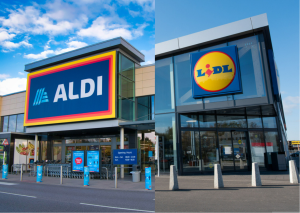Since Tesco launched its Aldi Price Match scheme in March 2020, it has become the copycat trend among UK supermarkets.
The likes of Sainsbury’s and more recently, Asda and Morrisons have launched their own versions of the initiative, which looks to match the prices of a select number of products to those offered by the discount grocers.
Now that the big four full-line grocers offer this scheme, does it still hold the same power?
Grocery Gazette looks into whether Morrisons was right to jump on the price match trend, whether it really works and how all grocery retailers can remain competitive in the race to win shoppers.

Morrisons followed Asda in price matching both Aldi and Lidl last month. Morrisons’ Price Match spans over 200 products including cupboard staples and household cleaning items, offering these at the same price or lower than at both the discounters.
Morrisons chief customer and marketing officer Rachel Eyre says the move comes as the retailer wants to “reassure our customers that we have hundreds of products that are the same price or cheaper – with the quality they’ve come to expect from us – than those available at Aldi and Lidl”.
It comes at a time when Morrisons needs to shout about it’s value credentials as its market share has dipped 0.2 percentage points to 8.8% year on year.
Really Good Culture retail specialist Phil McMahon believes it was inevitable that Morrisons would make this move.
“UK supermarkets have been in a perpetual copycat cycle for years. It was inevitable that market conditions would compel Morrisons to join the fray on price matching,” he says.
McMahon also believes it was “the right thing to do by their loyal customers”.
“I don’t think Morrisons price match campaign alone will be a silver bullet that sets them on a path to regaining any significant market share, but it will help them to maintain relevance and a level of competitiveness.”
However, IPLC partner Paul Stainton questions the move. “I think it’s boring. Yet again, another retailer just puts the name Aldi and Lidl in their customers’ minds.”
He also flags that Morrisons price match is weaker than it’s competitors. Although more products may be added to the newly-launched scheme over time, he points out that the 200 products it covers is notably fewer than the 600 plus in both Tesco and Sainsbury’s schemes.
Stainton notes: “The points of sale are fantastic. The execution online and TV advertising are all really strong but when you look at it, it’s 200 items and they sell around 25,000. It’s just such a small part of the range.”
McMahon agrees that “if it really wants to make a statement and lure people away from Tesco, Sainsbury’s, Aldi and Lidl, it will need to accelerate towards having 600+ products price matched.”
However, he points out that Morrisons decision to price match both Aldi and Lidl gives it a slight advantage. “It means that it is prepared to go further than Tesco and Sainsbury’s to deliver the lowest prices.”
However, he believes that in the long-term, price matching is risky and questions whether it is sustainable.
“If inflation continues to decline and Aldi and Lidl progress with expansion plans, it will naturally heap pressure on Morrisons and Asda to keep up,” he says.
“Morrisons does look to be trying to improve its working capital position though, and that could be a key enabler for their long-term price matching strategy.”

Geradin Partners competition lawyer and former CMA director Tom Smith says that one of the biggest concerns in price matching surrounds competition.
“The supermarkets clearly think that price match schemes attract customers and boost sales. This ought normally to be good for consumers too. However, there must come a point where their efficacy declines because these schemes cover a large proportion of the firms that are directly competing with each other,” he explains.
“The Competition and Markets Authority (CMA) may start to worry that the supermarkets’ incentives to reduce prices will be dampened because they know there is no point in doing so. They could all come to recognise that price competition only hurts them all and prices could then drift upwards.”
He also argues that these schemes could “lull consumers into a false sense of security if they assume a supermarket’s prices are the lowest available and they don’t shop around for themselves”.
Last year, the CMA’s groceries report found that consumers were savvy during periods of high inflation and that they did switch purchases towards better deals.
Smith adds that the CMA “might be sensitive to any situation that weakened that savviness”.

For retailers to ensure their price match schemes stand out from competitors, McMahon says they “need to do it as much as possible across all categories,” and “find creative ways to add value”.
He explains: “If you’re going to price match Aldi on carrots, then teach customers about your carrots. Talk about provenance, tell shoppers about different types of carrots, sell different types of carrots, explain the health benefits, create new recipes to help customers enjoy carrots in new ways and then sample them in-store. Make the fixture more attractive, and merchandise them next to unexpected products.”
McMahon says that by doing this, it could lead to consumers potentially trading up and increasing their average spend.
However, he says that on a wider scale, as well as making price match schemes more attractive to shoppers, supermarkets should “focus on their own identity and values to create reasons for their stores to be customers’ first preference”.
“Look what M&S is doing; really nice store environments, reinforcing product quality, impressive seasonal ranges, and attracting and retaining a happy and motivated customer-facing workforce with improving pay and benefits. It has a distinct identity and store experience, and the nation loves it for it.”
Stainton agrees that “making their stores exciting like M&S” would create a real point of difference for the grocers.
He adds that Morrisons specifically should “find its mojo” by going back to making its stores unique.
“It used to be famous for the Market Streets environment. It used to be a great place to go in and see something different to a Tesco or an Asda,” he says, suggesting that this is no longer the case.

Rather than hurting the discounters, Stainton believes that price match schemes in fact “help them get more publicity”.
However, he adds that price matching can have some downsides for Aldi and Lidl.
“It increases the resource they physically have to put into monitoring all the schemes.
“It’s a small thing but the amount of discussion that Aldi had when Tesco first launched its price match and the continual monitoring of what was claimed to be priced matched and what wasn’t, what was coming into the scheme and coming out of it – it’s an absolute headache for Aldi.”
He explains that these are still some examples where the price matched product is not the same specification as the Aldi or Lidl product and “therefore in theory, it’s not a true price match”.
Small examples include some fresh pork pies where Morrisons is 20% pork and Aldi’s is 28% pork, and peanut butter where Morrisons says 92% peanuts and Aldi’s is 96%, he says.
“What Aldi could do is say these campaigns are disingenuous, they’re not comparing like for like, but I’m guessing that the positive benefit that they’re getting from PR is outweighing all of this and it’s not worth their while.”
McMahon says that the schemes are more likely to “affect market share movements between the traditional big four rather than take share from Aldi or Lidl, who are likely to retain the loyalty of existing customers”.
However, for the discounters to remain competitive, “they should play to their key strength – low pricing”, he adds.
“If their expansion plans in the coming years involve opening bigger stores with expanded categories then they could present even more reasons for shoppers to reconsider where their loyalties lie.
“In the long-term, I think Aldi and Lidl could take prices down to a point that the other supermarkets cannot sustain, ultimately forcing them to quietly reduce focus on their price matching campaigns or even abandon them altogether.”
Ultimately, it appears that Morrisons has made the right move in joining its rivals in offering a price match scheme, for now.
However, with all of the big four full-line grocers providing such similar schemes, they also need to shout about what else they can offer if they are to really win customer spend.